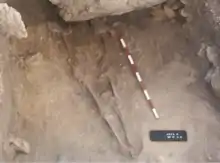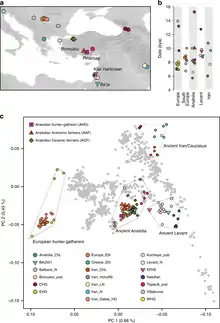Anatolian hunter-gatherers
Anatolian hunter-gatherers (AHG) were a human Epipaleolithic population that inhabited central Anatolia around 13,642-13,073 BCE. This population constitutes one of the three currently known ancestral genetic contributions of the present-day Europeans: Western European Hunter Gatherers (WEHG), Anatolian Neolithic Farmers (AHG) and Ancient North Eurasians (via Western Steppe Herders.)[1]
Introduction

The existence of this ancient population has been inferred[1] through the genetic analysis of the remains of a male individual from the site of Pınarbaşı (37 ° 29'N, 33 ° 02'E), in central Anatolia, which has been dated at 13,642-13,073 cal BCE. This population is genetically differentiated from the rest of the known Pleistocene populations.
It has been discovered[1] that populations of the Anatolian Neolithic derive a significant portion of their ancestry from the AHG, suggesting that agriculture was adopted in situ by these hunter-gatherers and not spread by demic diffusion into the region.
Genetics

At the autosomal level[1], in the Principal component analysis (PCA) the analyzed AHG individual turns out to be close to two later Anatolian populations, the Anatolian Aceramic Farmers (AAF) dating from 8300-7800 BCE, and the Anatolian Ceramic Farmers (ACF) dating from 7000-6000 BCE. These early Anatolian farmers later replaced the European hunter-gatherers populations in Europe to a large extent, ultimately becoming the main genetic contribution to current European populations, especially those of the Mediterranean. In addition, their position in this analysis is intermediate between Natufian farmers and Western hunter-gatherers (WHG). This last point is confirmed by the ADMIXTURE and qp-Adm analysis and confirms the presence of hunter-gatherers of both European and Near-Eastern origins in Central Anatolia in the late Pleistocene. Regarding their genetic proximity to the WHG, it has been proven that this proximity is greater with the so-called Villabruna cluster, which lived in Europe 14,000 years ago, and in particular with the individual known as Iron Gates HG, from the Balkans . The detailed study of these results suggests that this affinity is not due to a genetic flow from the AHG to the ancestors of the Villabruna cluster, but on the contrary: there was a genetic flow from the ancestors of the Villabruna cluster to the ancestors of the AHG.
Uniparental markers
The individual analyzed belongs to Y-chromosomal haplogroup C1a2 (C-V20), which has been found in some of the early WHGs, and mitochondrial haplogroup K2b. Both paternal and maternal lineages are rare in modern Eurasian populations.
See also
References
- Krause, Johannes; Jeong, Choongwon; Haak, Wolfgang; Posth, Cosimo; Stockhammer, Philipp W.; Mustafaoğlu, Gökhan; Fairbairn, Andrew; Bianco, Raffaela A.; Julia Gresky (2019-03-19). "Late Pleistocene human genome suggests a local origin for the first farmers of central Anatolia". Nature Communications. 10 (1): 1218. doi:10.1038/s41467-019-09209-7. ISSN 2041-1723. PMC 6425003. PMID 30890703.